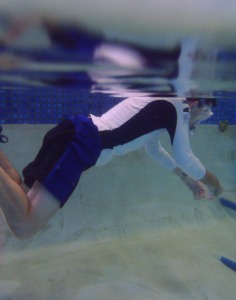Connect with the breath underwater
by Nancy B. Loughlin
Published in News Press on May 6, 2014. Posted with permission.
Take your yoga to the water.
Water is the balancing element for the second chakra, the sacrum. As you breathe underwater and experience Ujjayi echoing through your mind and body, meditate on your ability to form healthy relationships, your creativity and your emotional health.
The Underwater Ujjayi Meditation
This water meditation is about the breath. Invest in a mask and snorkel. If you are going to venture beyond the pool and into the sea, it’s best to get a dry top snorkel.
Ujjayi breathing, also known as Victorious Breath, is a mainstay of yoga and qigong practice.
Here’s Ujjayi on dry land: On the inhalation, constrict the throat and pull in the breath through the nose. If it isn’t working, try panting like a dog. When you’ve got the rhythm, close your mouth, and continue the pant.
Now slow it down.
This deep and conscious breathing focuses the mind. What’s even more important is that it decreases the number of breaths per minute. This slows the heart rate and activates the healing parasympathetic nervous system. It brings serenity to the mind and body. Renew and relax.
What differentiates Ujjayi from other forms of pranayama is the ocean-like sound.
Taking it to the water is apropos.
Stand in the water and feel the current energize your body. While wearing the mask and with the snorkel in your mouth, time your inhalations and exhalations with each step into deeper water. When you are up to your chin, drop your face into the water so your ears are covered. Float on your belly and breathe through the snorkel, listening to your ocean.
Focus on the sound, and allow the waves to slow the breath. If you choose, add some laps for aerobic exercise. Slip fins onto your feet. Allow four patient kicks on the inhale, two for the pause and six for the exhale. Don’t outpace your breath.
You should sound like a relaxed Darth Vader.
Scuba Asana
If being underwater resonates with you, step it up to Scuba Asana. It’s worth getting certified.
Hover Meditation
The goal of the hover is to maintain a neutral position in the water, rising and falling with the breath. For scuba aficionados, this begins with deflating your buoyancy vest, your BCD, and sinking to the bottom of the pool or ocean. Once you are down, take a test inhalation. Your body probably won’t rise.
Gently pump the inflate button on your BCD once. Inhale. Once you rise, exhale and fall. As you continue to breathe and float, perhaps close your eyes, cross your legs and hold the tips of your fins. Hover in mid-water.
As you breathe, notice how the inhalations and exhalations begin to overlap. Before the exhalation is even complete, the inhalation begins. Visualize the inhalation lifting your spirit. Exhale all energetic loads and sink.
The beauty of the hover asana is that it isn’t immediately accessible. It takes practice and patience.
Fin Pivot Meditation
Lie flat on your stomach on the bottom of the pool or ocean. Keep your legs straight and the tips of your fins touching the bottom. Inhale as a test.
To rise, gently inflate your BCD until you ascend on the inhalation. As you exhale, the upper body will sink toward the bottom. Continue the breath, rising to a 45-degree angle and falling. Cross your arms in front of your chest.
In buoyancy find balance.

